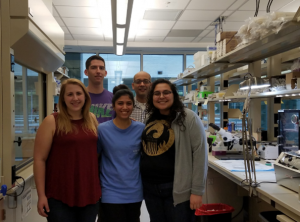Q & A with APDA research grant recipients
Since 1961, APDA has been a funding partner in many major scientific breakthroughs and has awarded more than $51 million in research grants to date.
APDA funds individual research grants and fellowships to scientists performing innovative Parkinson’s disease (PD) research. Grants are awarded through a competitive application process and reviewed by APDA’s Scientific Advisory Board (SAB). The SAB is comprised of scientists with a wide array of backgrounds and expertise in all areas relevant to PD research.
Today, we will introduce you to three of our researchers and highlight how APDA funding was crucial to helping these scientists conduct their vital work and build their PD research careers. You can read about three additional past researchers in a previous post.
Emily Rocha, grant recipient in 2015
You received a grant from APDA in 2015. Can you give us a brief summary of the results of that project and its potential implications for the PD community?

The goal of my postdoctoral award was to determine how an enzyme, glucocerebrosidase (GCase), works to prevent accumulation of α-synuclein in the neuron, thought to be a key feature of PD pathology. GCase is a lysosomal enzyme which breaks down molecules in the cell that are not needed. Dysfunction in the lysosomal system can lead to accumulation of cellular products in the cell that can have various negative effects. We looked to see whether GCase required another protein called transcription factor EG (TFEB) to do its job. We also set out to assess whether introduction of GCase and TFEB into cells allowed them not just to prevent accumulation of α-synuclein, but rather to remove high levels of intracellular α-synuclein, a situation that would be necessary for treatment of established PD.
This project yielded very promising preliminary data. We concluded that overexpression of GBA (the gene that encodes GCase) can help to move more TFEB into the nucleus where it does its job. We also found that overexpression of TFEB can prevent accumulation of α -synuclein in a rat dopaminergic cell line.
Based on the preliminary data collected from this postdoctoral award we were able to move forward. We are now working with a start-up company based in Pittsburgh named Generian Pharmaceuticals. This company has developed a small molecule that uniquely allows TFEB to remain active longer. Based on recent preliminary data we have collected, we hypothesize that allowing TFEB to remain active longer is neuroprotective and prevents dopaminergic degeneration.
We also have recently conducted work showing that overexpression of GBA in the midbrain can prevent dopaminergic degeneration in a rat model of PD.
The potential implications of these findings are huge for the PD community. We are actively assessing two new therapeutic approaches (small-molecule and gene therapy) to halt and prevent ongoing neurodegeneration.
What has been the general trajectory of your research and your career since 2015?
Since completing the APDA grant as a postdoctoral fellow under the mentorship of Dr. J. Timothy Greenamyre at the University of Pittsburgh (Note from Dr. Gilbert: Dr. Greenamyre is on APDA’s Scientific Advisory Board and recently answered questions about PD and gene therapy), I am now a Research Assistant Professor within the department of Neurology at the University of Pittsburgh and have been awarded several other research grants and published several high-impact manuscripts.
Did your APDA grant help shape the next steps of your research? If so, how?
Absolutely! My entire research program has been developed around this APDA grant. I published a recent manuscript in early 2020 that characterized lysosomal dysfunction in idiopathic PD. I also wrote a review article in 2018 on alpha-synuclein in PD that has been cited more than 210 times. I am currently working on two separate National Institutes of Health (NIH) funded grant applications each focused on lysosomal biology with a special emphasis on TFEB and GBA1 in Parkinson’s disease and aging.
What would you say to donors who are considering giving to APDA? Why is their support of APDA research important?
Philanthropy is vital to moving science forward. Only with the help of the entire community will we be able to find a cure for Parkinson’s disease. APDA has made significant contribution to the field by funding critical projects that have demonstrated that lysosomal dysfunction is a major pathological component to the disease, and only with continued support will scientists be able to find a cure for PD.
Serene Paul, grant recipient in 2015.
You received a grant from APDA in 2015. Can you give us a brief summary of the results of that project and its potential implications for the PD community?

While levodopa treatment has beneficial effects on motor symptoms for people with PD, some people hypothesized that it may adversely affect motor learning; this is known as the dopamine overdose hypothesis. We conducted a pilot randomized controlled trial to investigate whether levodopa affects learning of a stepping task in people with PD, by randomizing participants into one of two groups: a group who learned the stepping task “on” medication and another group who learned “off” medication. We found that there was no difference between groups, with both groups learning the stepping task to a similar extent. The potential implications of our findings are that (1) people with mild to moderate PD are capable of learning new tasks with practice, underscoring the importance of rehabilitation to improve and maintain function, and (2) as there is no evidence that levodopa hinders motor learning, the motoric benefits of levodopa may augment learning.
I recently had a paper published about my work on the topic of dopamine replacement therapy and motor learning.
What has been the general trajectory of your research since 2015?
When I received my APDA award, I was a post-doctoral fellow in the Department of Physical Therapy at the University of Utah. Since then, I moved to the University of Sydney in Australia where I am a Senior Lecturer. My current research interests have expanded from exercise and falls prevention to focus more on implementation, as I seek novel ways to improve access to evidence-based exercise interventions for people with PD, particularly at early stages of disease and for those with limited access to healthcare (e.g., people living in rural areas).
Did your APDA grant help shape the next steps of your research? If so, how?
My APDA grant allowed me to continue pursuing research with world-leading experts in the field, thereby broadening my research skills, while also enabling me to refine my interests in translational research to improve service delivery and accessibility for people with PD.
What would you say to donors who are considering giving to APDA? Why is their support of APDA research important?
Donations to APDA are crucial for helping young and emerging researchers increase the impact of their work and build the evidence base for novel and effective treatments to improve function and quality of life for people with PD. Support of APDA research is also very important because although PD is a common neurodegenerative condition, compared to other diseases such as cancer or cardiovascular disease, the number of people with PD is relatively small, so PD is often not seen as a priority for many government research grant schemes. Nevertheless, PD is associated with high levels of disability as the disease progresses and huge healthcare costs overall, making it crucial that we find ways to improve quality of life, reduce healthcare costs and ultimately find a way of lessening the impacts of this disease for people with PD, their families and the entire community.
Rahul Srinivasan, grant recipient 2017
You received a grant from APDA in 2017. Can you give us a brief summary of the results of that project and its potential implications for the PD community?

In 2017-18, I was a recipient of a research grant from APDA for studying the neuroprotective effects of smoking cessation drugs on PD. I am very happy to report that thanks to this seed funding from the APDA, my lab has recently published a paper in the Journal of Neurochemistry showing that very low doses of the smoking cessation drug, cytisine, exerts neuroprotection in a 6-OHDA mouse model of PD, but only in female mice. I am currently following up on this intriguing sex difference in the hopes that this finding will soon allow us to develop translationally relevant neuroprotective drug combinations for PD that can be used in men and women.
What has been the general trajectory of your research since 2017?
Since the APDA grant and because of the results I was able to obtain from the APDA grant, I am pleased to report that I was awarded an NIH-funded grant to support my work. I am now publishing a number of scientific papers on the topic of sex differences in PD. Overall, the trajectory of my research has been on a steep climb in terms of funding, papers and new directions of PD research prog ram thanks to the APDA seed grant that I received.
Did your APDA grant help shape the next steps of your research? If so, how?
Before the APDA grant, I was not thinking about sex differences in PD. As a result of experiments that I conducted using the seed funding from APDA, I discovered that the neuroprotective effect of a smoking cessation drug, cytisine occurs only in female mice and that estrogen and cytisine act in combination to exert neuroprotection. Thus, the APDA funding has enabled me to launch an entirely new research program in my lab focused on sex differences in PD, which I will be pursuing for the foreseeable future. My hope is to utilize knowledge gained from this research to develop a new class of neuroprotective drugs for PD, based on our understanding of sex differences in neuroprotection due to the drug cytisine.
What would you say to donors who are considering giving to APDA? Why is their support of APDA research important?
The support of APDA enables researchers like me to explore new research directions for treating and curing PD, and will eventually help us get much closer to a cure for PD.
Thank you to APDA from the bottom of my heart!
Tips and Takeaways
- Drs. Rocha, Paul and Srinivasan are just three of the many researchers APDA has funded in the past.
- APDA strives to fund the scientists who will bring the field of PD research closer to new treatments, and eventually, a cure.
- We are proud that our grants support new ideas in PD research and help shuttle these ideas into more involved research programs.
- Our research program is only possible due to the support and generosity of our donors. Click hereto help us in this critical mission.
- We encourage you to learn more about all of the research APDA has funded over the years.
- To learn more about some of the researchers APDA is currently supporting, you can read our recent interviews with Dr. Karen Nuytemans, Mohammad Shahnawaz, Dr. Vikram Khurana and Dr. Edward Griffin.
- You can also view our recent Virtual Research Roundtable program where we spoke with four current APDA researchers about their work and answered questions live from the audience during the program.
